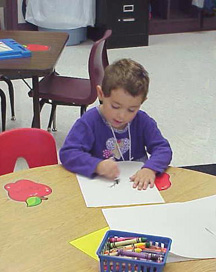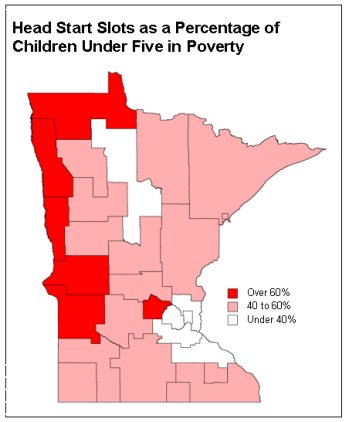January 12, 2001
Major Findings:
 Key Recommendations:
Key Recommendations:
Report Summary
Minnesota funds and regulates a variety of child care and education-related programs that are targeted to prekindergarten children. We examined three large early childhood education programs—Head Start, Early Childhood Family Education (ECFE), and School Readiness. State funding for these three programs totals about $50 million for fiscal year 2001.
 Programs Have Differing Designs, Costs, and Participant Characteristics
Programs Have Differing Designs, Costs, and Participant Characteristics
Head Start, ECFE, and School Readiness all aim to foster the healthy development of children. But, by design, these programs differ in their approaches. Head Start primarily serves low-income children ages three to five, while ECFE serves all ages of prekindergarten children and is open to all families without regard to income. Head Start provides many direct services to children, while ECFE relies more on parent education and service referrals. School Readiness is intended to fill the gaps not met by other programs, and it does this through a wide variety of activities directed toward children and parents. Children participating in Head Start are more likely to be poor, racial or ethnic minorities, and from one-parent families than children in ECFE or School Readiness.
On average, Head Start services are more comprehensive and intensive than ECFE and School Readiness services. Most Head Start programs provide 14 to 30 hours of direct services to children per week, for 9 to 12 months a year. In contrast, ECFE classes usually are two hours per week, and parents may attend classes for one to nine months a year. School Readiness services are determined partly on the basis of health and developmental screening, and nearly one-half of the children in School Readiness receive less than 30 hours of services during the year.
Service differences such as these explain most of the differences in the programs' annual costs. <FN - In addition, Head Start pays for some transportation and facilities costs that many ECFE and School Readiness programs do not bear.> Statewide, Head Start costs over $5,000 per participating child, while ECFE and School Readiness cost less than $500 per child. Although Head Start's costs per child are higher, its teacher salaries are one-half those paid to school districts' ECFE and School Readiness teachers.
Minnesota's Head Start Funding Is Generous but School Readiness Funding Is Modest
Minnesota is 1 of only 17 states that supplement the federal Head Start program with state funding. State funds account for about one-fourth of Minnesota's total Head Start revenues, which is the fifth highest nationally. In 2000, state funds enabled Minnesota Head Start programs to serve nearly 3,000 more children than would otherwise have been served. The 1997 Legislature significantly increased Head Start funding, resulting in a corresponding increase in state-funded service hours.
Minnesota (with its School Readiness program) is 1 of 36 states with publicly funded preschool-type programs other than Head Start. Minnesota's School Readiness spending per state resident under age five was below the spending median of the states with such programs. The state (Georgia) with the most generous funding for preschool programs other than Head Start spent four times more per state resident under age five than Minnesota spent for School Readiness and Head Start combined.
State Head Start Funding Could Target Unmet Needs More Effectively
 In fiscal year 2000, Head Start programs in Minnesota had funding sufficient to serve 45 percent of the state's 1990 census estimate of children ages three to five in poverty. Only three states' Head Start programs serve larger percentages of their children in poverty.
In fiscal year 2000, Head Start programs in Minnesota had funding sufficient to serve 45 percent of the state's 1990 census estimate of children ages three to five in poverty. Only three states' Head Start programs serve larger percentages of their children in poverty.
Minnesota law allocates one-half of the state's Head Start appropriation on the basis of federal Head Start allocations, but the federal allocations do not adequately reflect the location of families in poverty. In 2000, service providers in the Twin Cities region were funded to serve about 33 percent of three- to five-year-olds in poverty, while providers in many rural areas of Minnesota were funded to serve more than 60 percent of the three- to five-year-olds in poverty.
Also, state Head Start funding allocations are not related to the types of programs that providers offer. Minnesota determines how many children each Head Start provider is authorized to serve by using federal cost-per-child rates that differ for each provider and are not based on present or proposed service costs. For instance, the number of children a provider is authorized to serve is not affected by whether the provider wishes to provide full-time or part-time services.
The Minnesota Legislature has authority to determine how state-appropriated Head Start funds are allocated, and it should consider an approach that relies less on federal allocation practices. The Legislature should also consider giving Head Start service providers more flexibility to determine which families to serve with their state funds—including families just above the federal Head Start income guidelines and families with children under age three.
Early Childhood Programs Are Widely Available, but Some School Districts Have Large Reserves
In the 1999-2000 school year, all but four Minnesota school districts offered ECFE services, and all but six offered School Readiness. About 24 percent of Minnesota's children under age five participated in ongoing ECFE classes or home visits in 1998-99, and others were served through special family activities. Districts with School Readiness programs served 32 percent of Minnesota's three- and four-year-olds. There is no clear, systematic basis for judging the extent to which the ECFE and School Readiness programs are serving Minnesota families interested in participating.
To ensure that districts use ECFE funds only for ECFE programs, state law requires districts to place all ECFE revenues in a reserve account. Many districts have accumulated large balances of unspent funds. The Minnesota Department of Children, Families, and Learning (CFL) has suggested that districts maintain 8 to 17 percent of annual ECFE revenues in reserve, but two-thirds of districts had more than 17 percent of their revenues in reserve in fiscal year 1999. Nearly a quarter of districts had more than 100 percent of annual ECFE revenues in reserve. Small districts with large reserves of unspent funds tended to provide fewer ECFE services than similarly-sized districts with small reserves.
The Legislature should consider various options for addressing large reserve fund balances, including: (1) restricting ECFE funding for districts whose reserve fund balances exceed a certain level; (2) eliminating or reducing the statutorily guaranteed minimum funding levels for districts with under 150 eligible children; or (3) allocating a portion of ECFE funding based on the actual number of persons served, not just the size of the eligible population. In addition, there is a need for better CFL oversight of local ECFE and School Readiness programs—through improved financial monitoring and more on-site program reviews.
The Impact of Minnesota's Programs Is Unclear
Nationally, various studies have shown that well-implemented early childhood programs can benefit children. However, the evidence is mixed about whether these benefits persist over time, and lessons from the research should be applied cautiously due to differences in programs from site to site. Studies have provided very limited evidence about the "right" age to intervene, the most effective types of services, and how long to intervene.
There have been many studies of Minnesota's ECFE and School Readiness programs, but none provide definitive evidence about the impacts that can be attributed to these programs. Some individual districts systematically track the progress of preschool program graduates who have entered the K-12 school system, but this is not done on a statewide basis. The Legislature should ask CFL to report as soon as possible on steps that would be required to track the K-12 school success of children who once participated in state-funded early childhood programs.
Summary of Agency Response:
In a letter dated January 2, 2001, Commissioner Christine Jax of the Department of Children, Families, and Learning said that the report is "informative and ambitious" and "generally presents a fair picture" of Minnesota's early childhood education programs. "We especially appreciate the recommendation regarding tracking the elementary school progress of children who participate in early childhood education programs," she said—although the department thinks that research on the outcomes of early childhood programs is "more convincing than the report purports."
The commissioner also said that "the report does not sufficiently recognize the difference in administrative frameworks between Head Start, a grant program, and School Readiness and ECFE, both school-based programs." School-based programs are more autonomous in their program design, she said, which explains some of the differences in program monitoring and data collection noted in the report.
Finally, the commissioner said that the report's use of averages and percentages "sometimes falls short of presenting the information necessary to complete the picture." For instance, "School Readiness and ECFE offer a broad continuum of services to an entire population rather than a prescribed set of services to a targeted population." Thus, families with the greatest needs in ECFE and School Readiness may receive 20 to 25 hours of family literacy services per week—well above the statewide average of service hours per family in these programs.
The Program Evaluation Division was directed to conduct this study by the Legislative Audit Commission in April 1999. For a copy of the full report, entitled "Early Childhood Education Programs (01-01)", 102 pp., published on January 12, 2001, please call 651/296-4708, e-mail Legislative.Auditor@state.mn.us, write to Office of the Legislative Auditor, Room 140, 658 Cedar St., St. Paul, MN 55155, or go to the webpage featuring the report. Staff who worked on this project were Joel Alter (project manager), Judy Randall, and Leah Goldstein.